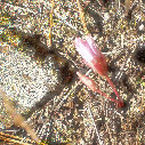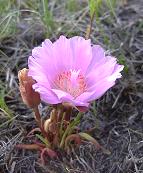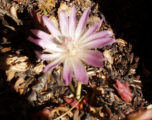
Lewis and Clark are credited with the "discovery" of the bitterroot plant (Lewisia Rediviva) in the Montana valley which was eventually named after it. It was known as Spetlum to the Native American peoples and had been an important part of their diet for unknown generations. The tribe's spring migrations were timed to coincide with the blooming of the bitterroot flower and often scouts would be sent out to alert the tribe to the readiness of the plant for harvesting.
Indian women dug, cleaned and boiled the root of the plant and then mixed it with meat or berries. Hunting expeditions and war parties often carried patties made from a mixture of pulverized root, deer fat and moss. At trading centers a sackful of bitterroot commanded a high price and could often be traded for a horse.
The species name rediviva refers to the hardiness of the plant. A bitterroot can live for over a year without water and is usually found growing in gravelly, dry soil. It is low-growing perennial with a fleshy taproot and has a branched base. In May and June a single flower will appear on each stem ranging in color from white to a deep pink or rose. When mature the bitterroot flower produces egg-shaped capsules which contain 6-20 nearly round seeds.
In 1895 the Montana Legislature sanctioned the symbol of the Bitterroot and on February 27, 1895 it became the official State Flower of Montana.
September 24, 1841, Father Pierre Jean DeSmet, together with his fellow Jesuit missionaries, Fathers Gregory Mengarini and Nicolas Point, and three Lay Brothers arrived in the Bitterroot valley. The mission they built, as well as the river and the tallest mountain peak to the west, were named "St. Mary's". The name of the river was changed to "Bitterroot" by the Forest Service many years later.
Today, three major geographic features owe their name to the bitterroot. The Bitterroot Mountains that run north-south and form the divide between Montana and Idaho, the Bitterroot River and the Bitterroot Valley. Businesses throughout the state employ the name of the beloved state symbol, the Bitterroot flower.
Spetlum
Lewisia Rediviva
Bitterroot
Bitterroot Flower and Its Place in Montana History
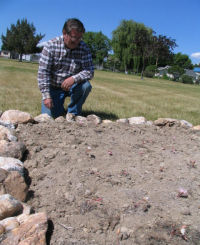
Bitterroot Garden at the Mission Complex
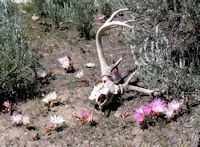
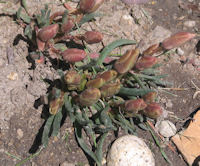
Bitterroot seed pods

Last Update: 8/24/2016
Historic St. Mary's Mission, Inc. * All Rights Reserved
Web Site Design by S&J Enterprises
406-777-5734
Email: stmary@cybernet1.com
www.saintmarysmission.org
P.O. Box 211
315 Charlo Street
Stevensville, MT 59870
